Donghyeong Kim
GenCLIP: Generalizing CLIP Prompts for Zero-shot Anomaly Detection
Apr 21, 2025Abstract:Zero-shot anomaly detection (ZSAD) aims to identify anomalies in unseen categories by leveraging CLIP's zero-shot capabilities to match text prompts with visual features. A key challenge in ZSAD is learning general prompts stably and utilizing them effectively, while maintaining both generalizability and category specificity. Although general prompts have been explored in prior works, achieving their stable optimization and effective deployment remains a significant challenge. In this work, we propose GenCLIP, a novel framework that learns and leverages general prompts more effectively through multi-layer prompting and dual-branch inference. Multi-layer prompting integrates category-specific visual cues from different CLIP layers, enriching general prompts with more comprehensive and robust feature representations. By combining general prompts with multi-layer visual features, our method further enhances its generalization capability. To balance specificity and generalization, we introduce a dual-branch inference strategy, where a vision-enhanced branch captures fine-grained category-specific features, while a query-only branch prioritizes generalization. The complementary outputs from both branches improve the stability and reliability of anomaly detection across unseen categories. Additionally, we propose an adaptive text prompt filtering mechanism, which removes irrelevant or atypical class names not encountered during CLIP's training, ensuring that only meaningful textual inputs contribute to the final vision-language alignment.
CoMoGaussian: Continuous Motion-Aware Gaussian Splatting from Motion-Blurred Images
Mar 07, 2025Abstract:3D Gaussian Splatting (3DGS) has gained significant attention for their high-quality novel view rendering, motivating research to address real-world challenges. A critical issue is the camera motion blur caused by movement during exposure, which hinders accurate 3D scene reconstruction. In this study, we propose CoMoGaussian, a Continuous Motion-Aware Gaussian Splatting that reconstructs precise 3D scenes from motion-blurred images while maintaining real-time rendering speed. Considering the complex motion patterns inherent in real-world camera movements, we predict continuous camera trajectories using neural ordinary differential equations (ODEs). To ensure accurate modeling, we employ rigid body transformations, preserving the shape and size of the object but rely on the discrete integration of sampled frames. To better approximate the continuous nature of motion blur, we introduce a continuous motion refinement (CMR) transformation that refines rigid transformations by incorporating additional learnable parameters. By revisiting fundamental camera theory and leveraging advanced neural ODE techniques, we achieve precise modeling of continuous camera trajectories, leading to improved reconstruction accuracy. Extensive experiments demonstrate state-of-the-art performance both quantitatively and qualitatively on benchmark datasets, which include a wide range of motion blur scenarios, from moderate to extreme blur.
Sparse-DeRF: Deblurred Neural Radiance Fields from Sparse View
Jul 09, 2024



Abstract:Recent studies construct deblurred neural radiance fields (DeRF) using dozens of blurry images, which are not practical scenarios if only a limited number of blurry images are available. This paper focuses on constructing DeRF from sparse-view for more pragmatic real-world scenarios. As observed in our experiments, establishing DeRF from sparse views proves to be a more challenging problem due to the inherent complexity arising from the simultaneous optimization of blur kernels and NeRF from sparse view. Sparse-DeRF successfully regularizes the complicated joint optimization, presenting alleviated overfitting artifacts and enhanced quality on radiance fields. The regularization consists of three key components: Surface smoothness, helps the model accurately predict the scene structure utilizing unseen and additional hidden rays derived from the blur kernel based on statistical tendencies of real-world; Modulated gradient scaling, helps the model adjust the amount of the backpropagated gradient according to the arrangements of scene objects; Perceptual distillation improves the perceptual quality by overcoming the ill-posed multi-view inconsistency of image deblurring and distilling the pre-filtered information, compensating for the lack of clean information in blurry images. We demonstrate the effectiveness of the Sparse-DeRF with extensive quantitative and qualitative experimental results by training DeRF from 2-view, 4-view, and 6-view blurry images.
CRiM-GS: Continuous Rigid Motion-Aware Gaussian Splatting from Motion Blur Images
Jul 04, 2024



Abstract:Neural radiance fields (NeRFs) have received significant attention due to their high-quality novel view rendering ability, prompting research to address various real-world cases. One critical challenge is the camera motion blur caused by camera movement during exposure time, which prevents accurate 3D scene reconstruction. In this study, we propose continuous rigid motion-aware gaussian splatting (CRiM-GS) to reconstruct accurate 3D scene from blurry images with real-time rendering speed. Considering the actual camera motion blurring process, which consists of complex motion patterns, we predict the continuous movement of the camera based on neural ordinary differential equations (ODEs). Specifically, we leverage rigid body transformations to model the camera motion with proper regularization, preserving the shape and size of the object. Furthermore, we introduce a continuous deformable 3D transformation in the \textit{SE(3)} field to adapt the rigid body transformation to real-world problems by ensuring a higher degree of freedom. By revisiting fundamental camera theory and employing advanced neural network training techniques, we achieve accurate modeling of continuous camera trajectories. We conduct extensive experiments, demonstrating state-of-the-art performance both quantitatively and qualitatively on benchmark datasets.
FIMP: Future Interaction Modeling for Multi-Agent Motion Prediction
Jan 29, 2024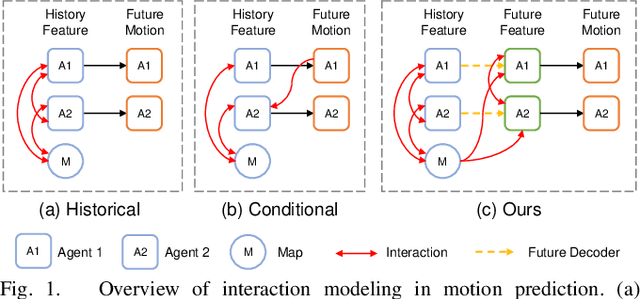
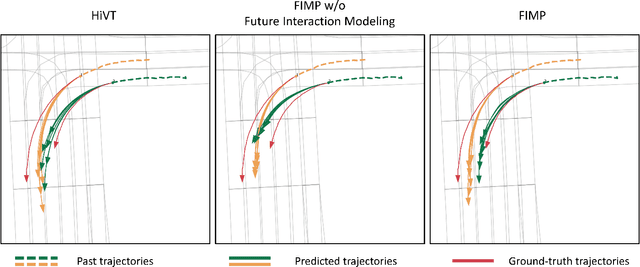

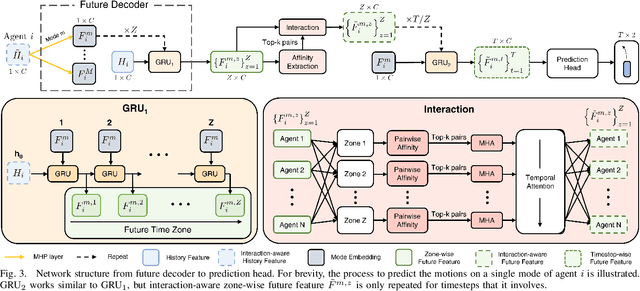
Abstract:Multi-agent motion prediction is a crucial concern in autonomous driving, yet it remains a challenge owing to the ambiguous intentions of dynamic agents and their intricate interactions. Existing studies have attempted to capture interactions between road entities by using the definite data in history timesteps, as future information is not available and involves high uncertainty. However, without sufficient guidance for capturing future states of interacting agents, they frequently produce unrealistic trajectory overlaps. In this work, we propose Future Interaction modeling for Motion Prediction (FIMP), which captures potential future interactions in an end-to-end manner. FIMP adopts a future decoder that implicitly extracts the potential future information in an intermediate feature-level, and identifies the interacting entity pairs through future affinity learning and top-k filtering strategy. Experiments show that our future interaction modeling improves the performance remarkably, leading to superior performance on the Argoverse motion forecasting benchmark.
Two-stream Decoder Feature Normality Estimating Network for Industrial Anomaly Detection
Feb 20, 2023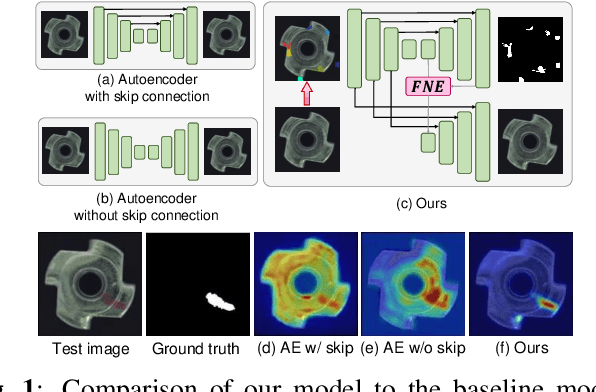

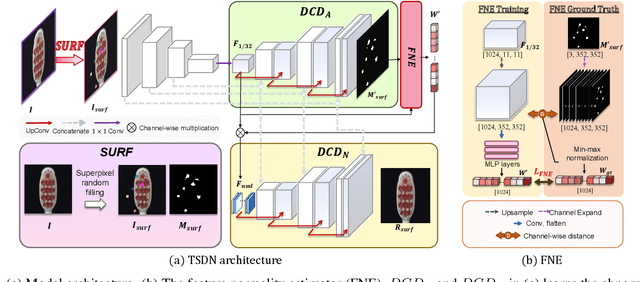
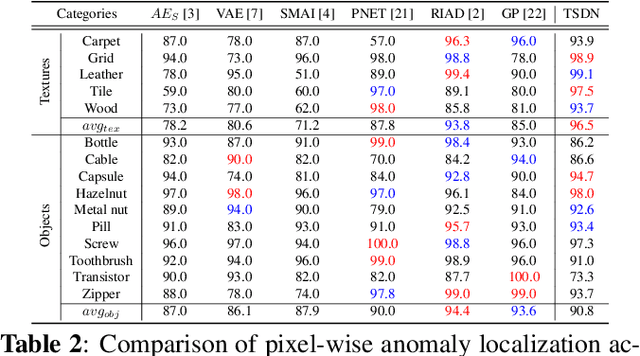
Abstract:Image reconstruction-based anomaly detection has recently been in the spotlight because of the difficulty of constructing anomaly datasets. These approaches work by learning to model normal features without seeing abnormal samples during training and then discriminating anomalies at test time based on the reconstructive errors. However, these models have limitations in reconstructing the abnormal samples due to their indiscriminate conveyance of features. Moreover, these approaches are not explicitly optimized for distinguishable anomalies. To address these problems, we propose a two-stream decoder network (TSDN), designed to learn both normal and abnormal features. Additionally, we propose a feature normality estimator (FNE) to eliminate abnormal features and prevent high-quality reconstruction of abnormal regions. Evaluation on a standard benchmark demonstrated performance better than state-of-the-art models.
FAPM: Fast Adaptive Patch Memory for Real-time Industrial Anomaly Detection
Nov 14, 2022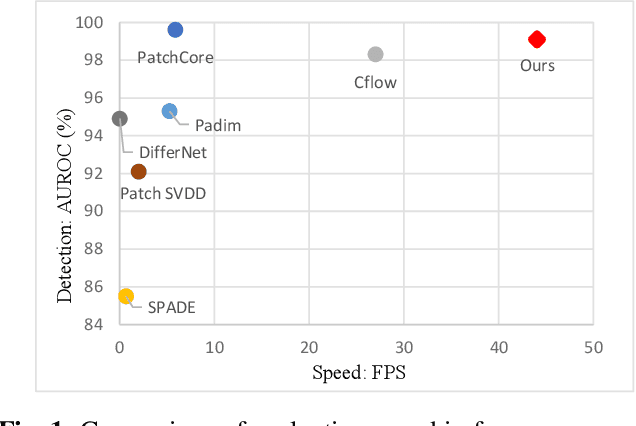
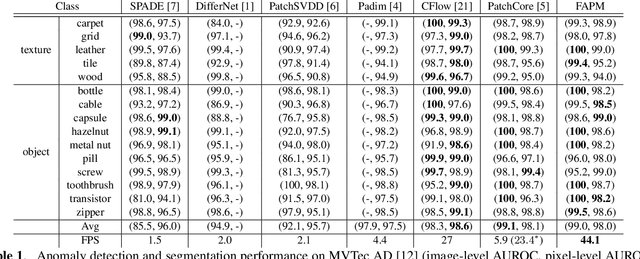
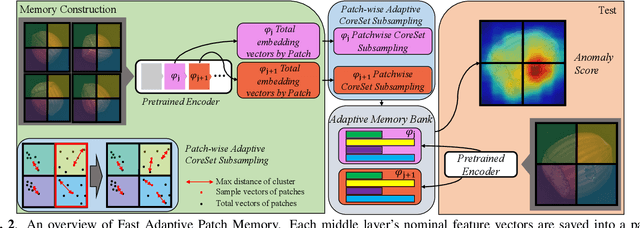

Abstract:Feature embedding-based methods have performed exceptionally well in detecting industrial anomalies by comparing the features of the target image and the normal image. However, such approaches do not consider the inference speed, which is as important as accuracy in real-world applications. To relieve this issue, we propose a method called fast adaptive patch memory (FAPM) for real-time industrial anomaly detection. FAPM consists of patch-wise and layer-wise memory banks that save the embedding features of images in patch-level and layer-level, eliminating unnecessary repeated calculations. We also propose patch-wise adaptive coreset sampling for fast and accurate detection. FAPM performs well for both accuracy and speed compared to other state-of-the-art methods.
Treating Motion as Option to Reduce Motion Dependency in Unsupervised Video Object Segmentation
Sep 04, 2022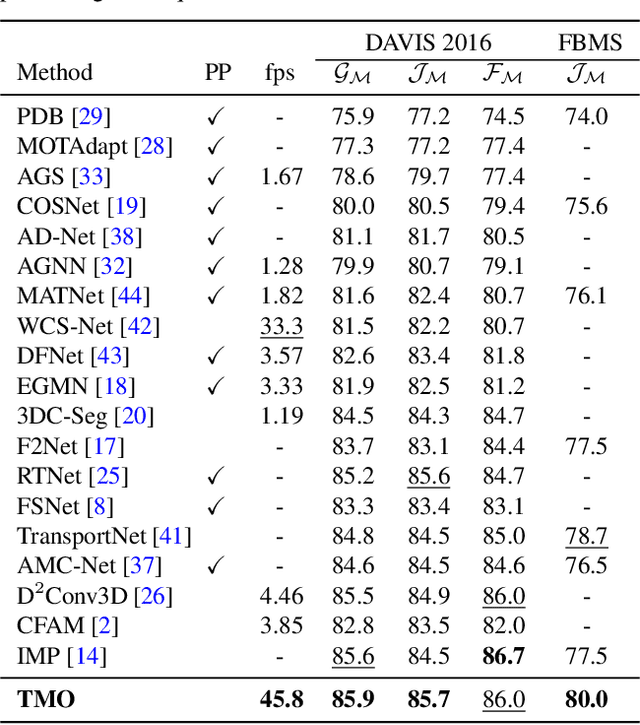



Abstract:Unsupervised video object segmentation (VOS) aims to detect the most salient object in a video sequence at the pixel level. In unsupervised VOS, most state-of-the-art methods leverage motion cues obtained from optical flow maps in addition to appearance cues to exploit the property that salient objects usually have distinctive movements compared to the background. However, as they are overly dependent on motion cues, which may be unreliable in some cases, they cannot achieve stable prediction. To reduce this motion dependency of existing two-stream VOS methods, we propose a novel motion-as-option network that optionally utilizes motion cues. Additionally, to fully exploit the property of the proposed network that motion is not always required, we introduce a collaborative network learning strategy. On all the public benchmark datasets, our proposed network affords state-of-the-art performance with real-time inference speed.
 Add to Chrome
Add to Chrome Add to Firefox
Add to Firefox Add to Edge
Add to Edge